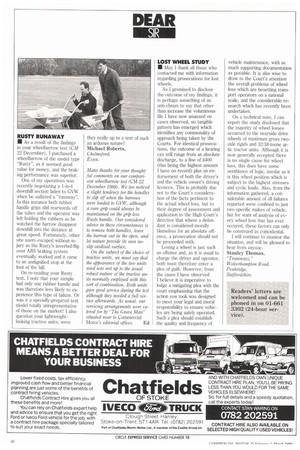RUSTY RUNAWAY • As a result of the findings in
Page 28

If you've noticed an error in this article please click here to report it so we can fix it.
your wheelbarrow test (CM 22 December), I purchased a wheelbarrow of the model type "Rusty", as it seemed good value for money, and the braking performance was superior.
One of my operatives was recently negotiating a 1-in-4 downhill section laden to GVW when he suffered a "runaway". In this instance both rubber handle grips slid rearwards off the tubes and the operator was left holding the rubbers as he watched the barrow disappear downhill into the distance at great speed. Fortunately, other site users escaped without injury as the Rusty's inverted/flip over ABS braking system eventually worked and it came to an undignified stop at the foot of the hill.
On re-reading your Rusty test, I note that your sample had only one rubber handle and was therefore less likely to experience this type of failure. Or was it a specially-prepared test Model totally unrepresentative of those on the market? I also question your lightweightlooking tractive units; were
they really up to a test of such an arduous nature?
Michael Roberts,
Chelmsford, Essex.
Many thanks for your thoughtful comments on our comparison wheelbarrow test (CM 22 December 1988). We too noticed a slight tendency for the handles to slip off when the barrows were loaded to GVW, although a sure grip could always be maintained on the grip-less Rusty handle. Our considered advice in these circumstances is to remove both handles, leave the barrow out in the open, and let nature provide its own noslip oxidised surface.
On the subject of the choice of tractive units, we must say that the appearance of the two units used was not up to the usual robust nature of the tractive units normally employed with this sort of combination. Both units gave good service during the test although they needed a full service afterwards. As usual, our servicing arrangements were catered for by "The Green Man" situated near to Commercial
Motor's editorial offices. Ed
LOST WHEEL STUDY • May I thank all those who contacted me with information regarding prosecutions for lost wheels.
As I promised to disclose the outcome of my findings, it is perhaps something of an anti-climax to say that other than increase the voluminous file I have now amassed on cases observed, no tangible pattern has emerged which identifies any commonality of approach being taken by the Courts. For identical prosecutions, the outcome of a hearing can still range from an absolute discharge, to a fine of P-400 (this being the highest amount I have on record) plus an endorsement of both the driver's and the vehicle owner's driving licences. This is probably due not to the Court's consideration of the facts pertinent to the actual wheel loss, but to their degree of assessment and application to the High Court's directive that where a defendant is considered morally blameless for an absolute offence, a prosecution should not be proceeded with.
Losing a wheel is just such an offence and, as it is usual to charge the driver and operator, both must therefore enter a plea of guilt. However, from the cases I have observed I believe it is imperative to lodge a mitigating plea with the court emphasising that the action you took was designed to meet your legal and moral responsibility to ensure vehicles are being safely operated. Such a plea should establish the quality and frequency of vehicle maintenance, with as much supporting documentation as possible. It is also wise to draw to the Court's attention the overall problems of wheel loss which are besetting transport operators on a national scale, and the considerable research which has recently been undertaken.
On a technical note, I can report the study disclosed that the majority of wheel losses occurred to the nearside drive wheels of maximum gross twoaxle rigids and 32/38-tonne artic tractor units. Although it is now generally accepted there is no single cause for wheel loss, this does have some semblance of logic, insofar as it is this wheel position which is subject to the highest stresses and cyclic loads. Also, from the information gathered, a considerable amount of all failures reported were confined to just two specific makes of vehicle, but for want of analysis of every wheel loss that has ever occured, these factors can only be construed as coincidental.
I will continue to monitor the situation, and will be pleased to hear from anyone.
Stanley Thomas,
"Tramways," Wolverhampton Road, Penkridge, Staffordshire.
















































































































































